Pearson made the right choice in selling the Financial Times
 There has been much hand-wringing about the sale of The Financial Times to Japanese media firm Nikkei. But the deal makes a lot of sense and – in many ways – is the least worst option for the newspaper and its associated publishing interests.
There has been much hand-wringing about the sale of The Financial Times to Japanese media firm Nikkei. But the deal makes a lot of sense and – in many ways – is the least worst option for the newspaper and its associated publishing interests.
The FT Group has, for some time, been an anomaly in Pearson’s portfolio. In the heady days of multi-interest conglomerates – when Pearson also owned Alton Towers and Madam Tussaud’s – there was no reason why the newspaper and a range of magazines could not be incorporated into a portfolio of interests. But in the years under Marjorie Scardino, and more recently under John Fallon, Pearson has become increasingly focused on a singular vision: to become the largest global educational publisher.
The move to focus more closely on educational publishing and e-learning is a smart proposition. Newspaper and magazine buyers are fickle. The governments that buy educational products and services are less fickle, they commit to curriculum decisions and tend to stick by them for at least a decade. If you’re a supplier of educational content and exams, that’s a great proposition. The FT doesn’t add value to that model.
Nikkei is a fitting partner, too. Writing in Wall St Journal, Simon Zekaria said Nikkei’s flagship daily, Nihon Keizai Shimbun, is a must-read for Japan’s business people, just as the FT is in the UK. In fact, both papers are so central to their respective countries’ economies that the leading stock market indices (the Nikkei and the FTSE) are named after them. There could have been a similar brand fit with Dow Jones and the WSJ itself, of course: but Rupert Murdoch’s acquisition of Dow Jones in 2007 was a signal that he had given up his long-held ambition to own the FT. He would also have needed to dispose of The Times – and probably the WSJ as well – to satisfy the competition authorities here and (possibly) in the US.
Another great advantage of this deal is that while the Japanese media landscape is rather more conservative than in the UK, Nikkei seem to understand that editorial independence is a given. This is heartening for the FT, which could have suffered so much more under other owners.
In addition, the FT has become far less of a purely UK-focused newspaper business over the last twenty years. Its global digital subscriber base now far outstrips its newspaper readership – even though the print product now shifts significant numbers overseas. A smart, metered gateway has proved highly successful in converting casual readers to annual subscriptions. And the Financial Times a globally trusted brand with a proven digital platform that will allow Nikkei access to markets where its own profile might prove problematic. The two fit well together, with neat synergies around the world.
It is less clear what the acquisition might mean for the group’s wider publishing interests as Nikkei has far less experience in periodical and B2B publishing.
The Investor’s Chronicle might expect a warm reception – and indeed investment – but I would imagine that many of the other titles might soon find new homes. They are not highly profitable and have a range of business models that Nikkei might struggle with.
The purchase also leads to the intriguing question of what will happen with Pearson’s 50% stake in The Economist, which does not form part of the deal with Nikkei.
Fallon has said there are no plans to sell, but I would give it six months. Pearson has sent a clear signal to the market that is looking to exit consumer media, and yet held back one of its most valuable assets. It is great corporate poker – and will undoubtedly pique interest from a range of players globally. Not least, I suspect, from Rupert Murdoch, who will be feeling bruised by the Nikkei deal.
Watch this space.